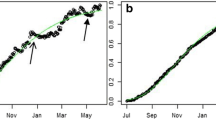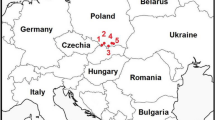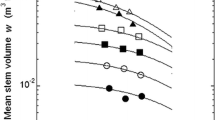Abstract
The allometric relationships between mean weights of components, such as stems, branches and leaves and tree weight as well as their time-trajectories, were studied with data of self-thinning Pinus densiflora stands with different densities. The allometric relationships existed between the weights of stems, branches and leaves and the tree weight during the course of self-thinning. The stem weight ratio increased with increasing tree weight because the allometric coefficient in stem was higher than unity, whereas the branch weight ratio and the leaf weight ratio decreased because the allometric coefficients in branches and leaves were less than unity. An allometric power relationship existed between mean component weight and mean tree weight during the course of self-thinning. The time-trajectory of mean component weight (w o) and density (ρ) in the early growth stage was expressed as a mathematical model which incorporates the allometric power relationship into the Tadaki’s model, whereas the model for describing w o-ρ trajectory in the later growth stage was derived by combining the allometric power relationship with 3/2 power law. The two models, Tadaki’s model and 3/2 power law, showed a good fit to data from P. densiflora stands. The time-trajectories of mean tree weight (w)-density (ρ) or w o-ρ initially almost moves nearly vertically in the low-density stand, moves along a steep curve and an inclined curve in the medium- and high-density stands, respectively, and gradually approaches self-thinning line in the early stage of stand development, whereas they reached and moved along the self-thinning line in the later stage of stand development. The self-thinning exponents were determined to be 1.71, 1.19 and 1.13 for the trees, 2.38, 1.33 and 1.20 for the stem, 3.16, 1.55 and 1.46 for the branches, 2.66, 1.39 and 1.35 for the leaves in the low-, medium- and high-density stands, respectively. The 3/2 power law of self-thinning is derived on the basis of simple geometric model of space occupation by growing trees, but allometric growth of tree and components can make the slope of the self-thinning line being different from −3/2. The reasons that the self-thinning exponents of components in the low-density stand were greater than those in the medium- and high-density stands were discussed.




Similar content being viewed by others
References
Aerts R (1999) Interspecific competition in natural plant communities: mechanisms, trade-offs and plant-soil feedbacks. J Exp Bot 50:29–37
Aerts R, Boot RGA, van der Aart PJM (1991) The relation between above- and belowground biomass allocation patterns and competitive ability. Oecologia 87:551–559
Alcorn PJ, Pyttel P, Bauhus J, Smith RGB, Thomas D, James R, Nicotra A (2007) Effects of initial planting density on branch development in 4-year-old plantation grown Eucalyptus pilularis and Eucalyptus cloeziana trees. For Ecol Manage 252:41–51
Ando T (1962) Growth analysis on the natural stands of Japanese red pine (Pinus densiflora Sieb. et Zucc.) II. Analysis of stand density and growth (in Japanese with English summary). Bull For For Prod Res Inst 147:45–77
Baldwin VC Jr, Kelly D, Peterson KD, Clark A III, Ferguson RB, Strub MR, Bower DR (2000) The effects of spacing and thinning on stand and tree characteristics of 38-year-old loblolly Pine. For Ecol Manage 137:91–102
Bégin E, Bégin J, Bélanger L, Rivest LP, Tremblay S (2001) Balsam fir self-thinning relationship and its constancy among different ecological regions. Can J For Res 31:950–959
Bi H (2001) The self-thinning surface. For Sci 47:361–370
Blake J, Somers G, Ruark G (1991) Estimating limiting foliar biomass in conifer plantations from allometric relationships and self-thinning behavior. For Sci 37:296–307
Burkes EC, Will RE, Barron GA, Teskey RO, Shiver B (2003) Biomass partitioning and growth efficiency of intensively managed Pinus taeda and Pinus elliottii stands of different planting densities. For Sci 49:224–234
Cabannetes A, Auclair D, Imam W (1999) Diameter and height growth curves for widely spaced trees in European agroforestry. Agrofor Syst 43:169–181
Crawley MJ (1997) The structure of plant communities. In: Crawley MJ (ed) Plant ecology, 2nd edn. Blackwell, Oxford, pp 475–531
Drew TJ, Flewelling JW (1977) Some recent Japanese theories of yield–density relationships and their application to Monterey pine plantations. For Sci 23:517–534
Ellison AM (1989) Morphological determinants of self-thinning in plant monocultures and a proposal concerning the role of self-thinning in plant evolution. Oikos 54:287–293
Ewanchuk PJ, Bertness MD (2004) Structure and organization of a northern New England salt marsh plant community. J Ecol 92:72–85
Firbank LG, Watkinson AR (1985) A model of interference within plant monocultures. J Theor Biol 116:291–311
Franklin JF, Spies TA, VanPelt R, Carey AB, Thornburgh DA, Berg DR, Lindenmayer DB, Harmon ME, Keeton WS, Shaw DC, Bible K, Chen J (2002) Disturbances and structural development of natural forest ecosystems with silvicultural implications, using Douglas-fir forests as an example. For Ecol Manage 155:399–423
Garber SM, Maguire DA (2005) Vertical trends in maximum branch diameter in two mixed-species spacing trials in the central Oregon Cascades. Can J For Res 35:295–307
Goudie JW, Polsson KR, Ott PK (2009) An empirical model of crown shyness for lodgepole pine (Pinus contorta var. latifolia [Engl.] Critch.) in British Columbia. For Ecol Manage 257:321–331
Grace JB (1999) The factors controlling species density in herbaceous plant communities: as assessment. Perspect Plant Ecol Evol Syst 2:1–28
Grace JB, Tilman D (1990) Perspectives on plant competition. Academic Press, San Diego
Grams TEE, Kozovits AR, Reiter IM, Barbro Winkler J, Sommerkorn M, Blaschke H, Häberle K-H, Matyssek R (2002) Quantifying competitiveness in woody plants. Plant Biol 4:153–158
Hagihara A (1996) Theoretical studies on the time-trajectory of mean plant weight and density in self-thinning populations. Bull Nagoya Univ For 15:51–67 (in Japanese with English summary)
Hagihara A (1998) A practical model for the time-trajectory of mean phytomass and density in the development of even-aged pure stands. J For Plann 4:65–69
Hara T (1984) Modelling the time course of self-thinning in crowded plant populations. Ann Bot 53:181–188
Harper JL (1977) Population biology of plants. Academic Press, London, p 892
Henskens FL, Battaglia M, Cherry ML, Beadle CL (2001) Physiological basis of spacing effects on tree growth and form in Eucalyptus globus. Trees 15:365–377
Hozumi K (1973) Interactions among higher plants. Kyoritsu-Shuppan, Tokyo 124 pp (in Japanese)
Hozumi K (1977) Ecological and mathematical considerations on self-thinning in even-aged pure stands. I. Mean plant weight–density trajectory during the course of self-thinning. Bot Mag (Tokyo) 90:165–179
Hozumi K (1980) Ecological and mathematical considerations on self-thinning in even-aged pure stands. II. Growth analysis of self-thinning. Bot Mag (Tokyo) 93:149–166
Hozumi K (1983) Ecological and mathematical considerations on self-thinning in even-aged pure stands. III. Effect of the linear growth factor on self-thinning and its model. Bot Mag (Tokyo) 96:171–191
Jobidon R (2000) Density-dependent effects of northern hardwood competition on selected environmental resources and young white spruce (Picea glauca) plantation growth, mineral nutrition, and stand structural development—a 5-year study. For Ecol Manage 130:77–97
Kira T, Ogawa H, Hozumi K, Koyama H, Yoda K (1956) Intraspecific competition among higher plants. V. Supplementary notes on the C-D effects. J Inst Polytech Osaka City Univ Ser D 7:1–14
Leuschner C, Hertel D, Coners H, Büttner V (2001) Root competition between beech and oak: a hypothesis. Oecologia 126:276–284
Longuetaud F, Seifert T, Leban JM, Pretzsch H (2008) Analysis of long-term dynamics of crowns of sessile oaks at the stand level by means of spatial statistics. For Ecol Manage 255:2007–2019
Malimbwi RE, Persson A, Iddi S, Chamshama SAO, Mwihomeke ST (1992) Effects of spacing on yield and some wood properties of Pinus patula at Rongai, northern Tanzania. For Ecol Manage 53:297–306
Mohler CL, Marks PL, Sprugel DG (1978) Stand structure and allometry of trees during self-thinning of pure stands. J Ecol 66:599–614
Neilsen WA, Gerrand AM (1999) Growth and branching habit of Eucalyptus nitens at different spacing and the effect on final crop selection. For Ecol Manage 123:217–229
Ogawa K (2001) Time trajectories of mass and density in a Chamaecyparis obtusa seedling population. For Ecol Manage 142:291–296
Ogawa K (2005) Time-trajectory of mean phytomass and density during a course of self-thinning in a sugi (Cryptomeria japonica D. Don) plantation. For Ecol Manage 214:104–110
Ogawa K, Hagihara A (2003) Self-thinning and size variation in a sugi (Cryptomeria japonica D. Don) plantation. For Ecol Manage 174:413–421
Pinkard EA, Neilsen WA (2003) Crown and stand characteristics of Eucalyptus nitens in response to initial spacing: implications for thinning. For Ecol Manage 172:215–227
Popescu SC, Wynne RH, Nelson RF (2003) Measuring individual tree crown diameter with lidar and assessing its influence on estimating forest volume and biomass. Can J Rem Sens 29:564–577
Pretzsch H (2002) A unified law of spatial allometry for woody and herbaceous plants. Plant Biol 4:159–166
Puettman KJ, Hann DW, Hibbs DE (1993) Evaluation of the size-density relationships for pure alder and Douglas-fir stands. For Sci 39:7–27
Putz FE, Parker G, Archibald M (1984) Mechanical abrasion and inter crown spacing. Am Midl Nat 112:24–28
Reynolds JH, Ford ED (2005) Improving competition representation in theoretical models of self-thinning: a critical review. J Ecol 93:362–372
Schenk HJ (2005) Vertical vegetation structure below ground: scaling from root to globe. Prog Bot 66:341–373
Schwinning S, Weiner J (1998) Mechanisms determining the degree of size asymmetry in competition among plants. Oecologia 113:447–455
Shibuya M (1995) A simple and practical model for mean size–density trajectories of tree stands. J Jpn For Soc 77:247–253
Shujauddin N, Kumar BM (2003) Ailanthus triphysa at different densities and fertiliser regimes in Kerala, India: growth, yield, nutrient use efficiency and nutrient export through harvest. For Ecol Manage 180:135–151
Silvertown J, Charlesworth D (2001) Introduction to plant population biology, 4th edn. Blackwell, Oxford 347 pp
Smith NJ, Hann DW (1984) A new analytical model based on the -3/2 power rule of self-thinning. Can J For Res 14:605–609
Solomon DS, Zhang LJ (2002) Maximum size–density relationships for mixed softwoods in the northeastern USA. For Ecol Manage 155:163–170
Tadaki Y (1963) The pre-estimating of stem yield based on the competition-density effect. Bull For For Prod Res Inst 154:1–19 (in Japanese with English summary)
Tadaki Y (1995) Structure and productivity of young Castanopsis cuspidata forests growing in different densities. Bull Nagoya Univ For 14:1–24
Tadaki Y, Takeuchi I, Kawahara T, Sato A, Hatiya K (1979) Growth analysis on the natural stands of Japanese red pine (Pinus densiflora Sieb. et Zucc.). III. Results of experiment (research note). Bull For For Prod Res Inst 305:125–144 (in Japanese)
Tewksbury JJ, Lloyd JD (2001) Positive interactions under nurseplants: spatial scale, stress gradients and benefactor size. Oecologia 127:425–434
Turnblom EC, Burk TE (2000) Modeling self-thinning of unthinned Lake States red pine stands using nonlinear simultaneous differential equations. Can J For Res 30:1410–1418
Weiner J, Thomas SC (1992) Competition and allometry in three species of annual plants. Ecology 73:648–656
Weiner J, Berntson GM, Thomas SC (1990) Competition and growth form in a woodland annual. J Ecol 78:459–469
Weller DE (1987) Self-thinning exponent correlated with allometric measures of plant geometry. Ecology 68:813–821
Weller DE (1991) The self-thinning rule: dead or unsupported?—a reply to Lonsdale. Ecology 72:747–750
Westoby M (1984) The self-thinning rule. Adv Ecol Res 14:167–225
White J (1981) The allometric interpretation of the self-thinning rule. J Theor Biol 89:475–500
White J, Harper JL (1970) Correlated changes in plant size and number in plant populations. J Ecol 58:467–485
Will RE, Narahari NV, Shiver BD, Teskey RO (2005) Effects of planting density on canopy dynamics and stem growth for intensively managed loblolly pine stands. For Ecol Manage 205:29–41
Wyckoff PH, Clark JS (2005) Tree growth prediction using size and exposed crown area. Can J For Res 35:13–20
Xue L, Hagihara A (1999) Density effect, self-thinning and size distribution in Pinus densiflora Sieb. et Zucc. stands. Ecol Res 14:49–58
Xue L, Hagihara A (2008) Density effects of tree organs in self-thinning Pinus densiflora Sieb. et Zucc. stands. Ecol Res 23:689–695
Xue L, Hagihara A, Tadaki Y, Du X (1997) Self-thinning in Prince Repprecht’s larch (Larix principis-rupprechtii Mayr) stands. J For Res 2:221–226
Yoda K, Kira T, Ogawa H, Hozumi K (1963) Self-thinning in overcrowded pure stands under cultivated and natural conditions (Intraspecific competition among higher plants XI). J Biol Osaka City Univ 14:107–129
Zeide B (1987) Analysis of the 3/2 power law of self-thinning. For Sci 32:517–537
Acknowledgments
This study was partially supported by Foundation of Guangdong Forestry Bureau (No. 4400-F07041, 4400-F06051).
Author information
Authors and Affiliations
Corresponding author
Additional information
Communicated by K. Puettmann.
Rights and permissions
About this article
Cite this article
Xue, L., Feng, Hf. & Chen, Fx. Time-trajectory of mean component weight and density in self-thinning Pinus densiflora stands. Eur J Forest Res 129, 1027–1035 (2010). https://doi.org/10.1007/s10342-010-0387-y
Received:
Revised:
Accepted:
Published:
Issue Date:
DOI: https://doi.org/10.1007/s10342-010-0387-y




